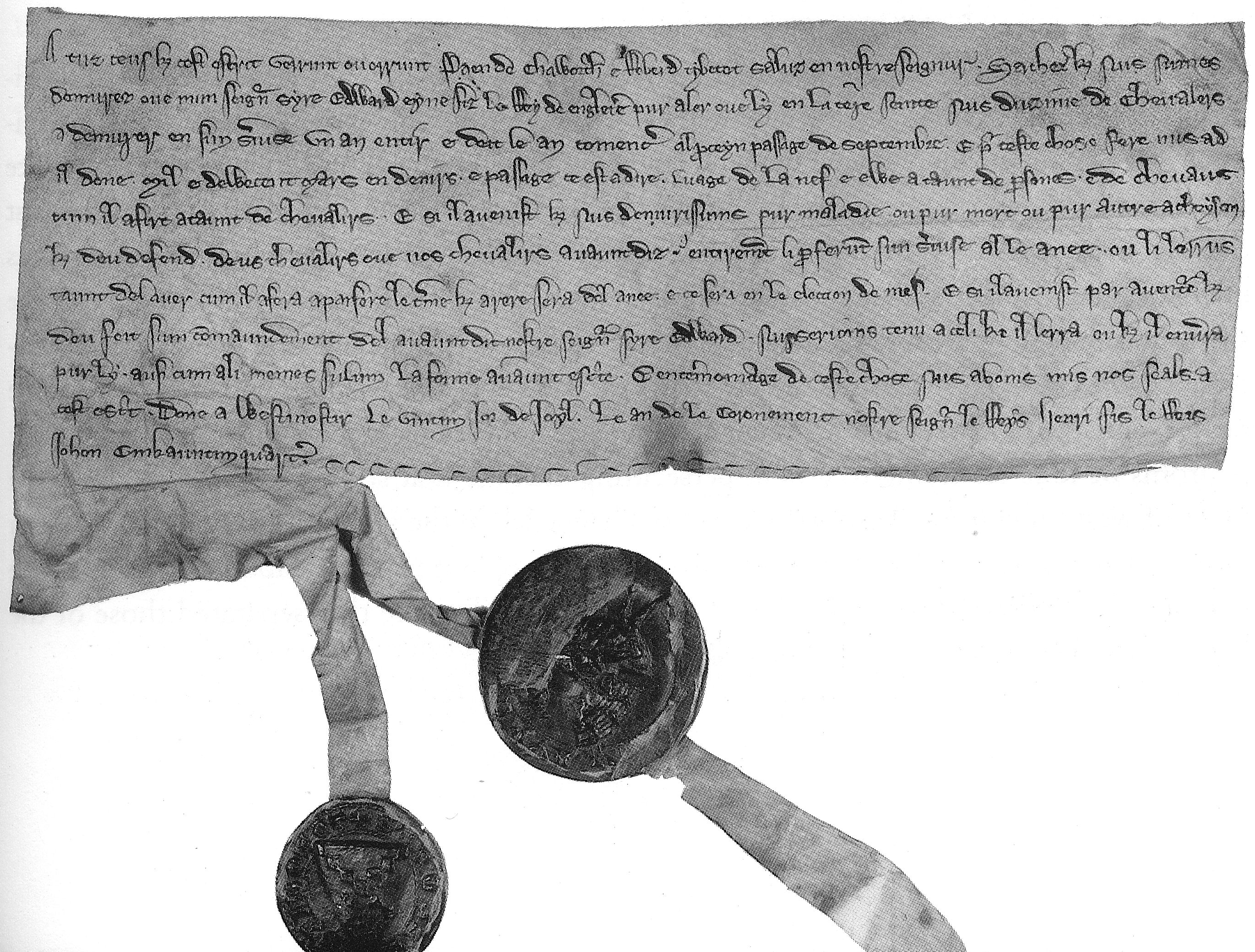
Real and False Crusading Charters
Thumbing through Crusades material, I found an interesting ancestral document concerning two figures, one of which at least has a large known modern descendancy (in my case, descending through Despenser, Wentworth, Waldegrave, Spring, Wright, and Derehaugh, to colonial Massachusetts). It is a contract, dated 20 July 1270, by which Sir Robert Tibetot and his brother-in-law Sir Payn de Chaworth agree to accompany the Lord Edward on crusade, "with five knights apiece, in return for shipping, water, and a fee of 100 marks for each knight." This Sir Robert Tibetot, with wife Ava de Chaworth (sister of Payn de Chaworth), was father of Payn de Tibetot, 1st Baron Tibetot.
Anyhow, the deed (with seals) is photographed in the Oxford Illustrated History of the Crusades, ed. Jonathan Riley-Smith (Oxford, 1995), p. 63. The text of the charter is not given in this book, and unfortunately the text is not easily legible in the photograph. Nevertheless one can pick out the names and certainly the engrailed or lozengy saltire of the Tibetot arms on smaller seal at lower left (the larger, not legible in the photo, is presumably for Chaworth). The charter is in the British Library, MS Additamenta:Chartae 19829. I recommend this book, which is about $20 in paperback. It is not a blow-by-blow history, rather a series of excellent general essays on various aspects of the Crusades.
[click to enlarge]
This contrasts interestingly with a fake charter, of which I'm also fond: one of the (unfortunately not famous enough) several hundred forged charters made for families desiring to have their ancestors' name and arms inscribed as crusaders in the Salles des Croisades, a suite of rooms built into the palace of Versailles in the late 1830s, at the initiative of King Louis-Philippe, to commemorate the glories of the French on crusade. The rooms were filled not only with historical paintings of moments in that history (for which see my thumbnail gallery at Brown University) but also hung with coats of arms of Crusaders. In addition to the great historical figures of the Crusades, courtiers of the July Monarchy were eager to set themselves apart from the crowd by proving a personal connection to crusading (and consequently the antiquity and nobility of their particular family). A vibrant business grew up in forging (on authentic scraps of old parchment) charters to place some perhaps entirely fictitious family founder at, say, the siege of Acre (1191) or Damietta (1217), or the crusade of Saint Louis (1250). A particularly elaborate (and expensive) forgery—it cost 500 Francs when forged to order in 1843—was that for the Chasteney family, placing one otherwise unattested chef de famille, Jean de Chasteney, at the siege of Acre; it also attests his heraldry since a goblet featuring a cock is explicitly mentioned in the charter (perhaps the alleged descendant actually possessed such a cup and requested that its provenance be written into the charter as well). The charter, with a tiny quitclaim pinned to the front, is preserved as Bibliothèque Nationale, MS Lat. 17803A:
Although at least one well-placed official who was also a paleographer suspected the hundreds of charters appearing at this time to be forgeries, no public accusations were made until long after the Salles des Croisades had become a dead issue, after the Franco-Prussian War. And not until the mid twentieth century did denunciations of these forgeries diffuse through crusading literature. The story of these ambitious forgeries (genealogical forgeries, of a kind) is most fully told by Robert-Henri Bautier, "La collection de chartes de croisade dite 'Collection Courtois'," Comptes-rendus des séances de l'Academie des Inscriptions et Belles Lettres (1956), 382-86; and "Forgeries et Falsifications de documents par une officine généalogique au milieu du XIXe siècle," Bibliothèque de l'Ecole des Chartes 142 (1974), 91-2; see also David Abulafia, "Invented Italians in the Courtois Forgeries," in Crusade and Settlement: papers read at the First Conference of the Society for the Study of the Crusades and the Latin East and presented to R.C. Smail, ed. P. W. Edbury (Cardiff, 1975), pp. 135-47.
rev 03/02/2007